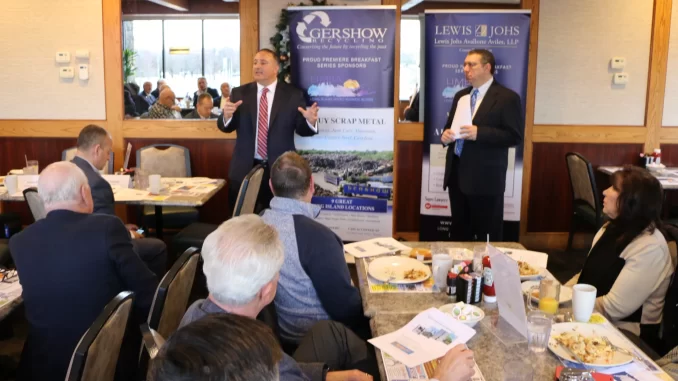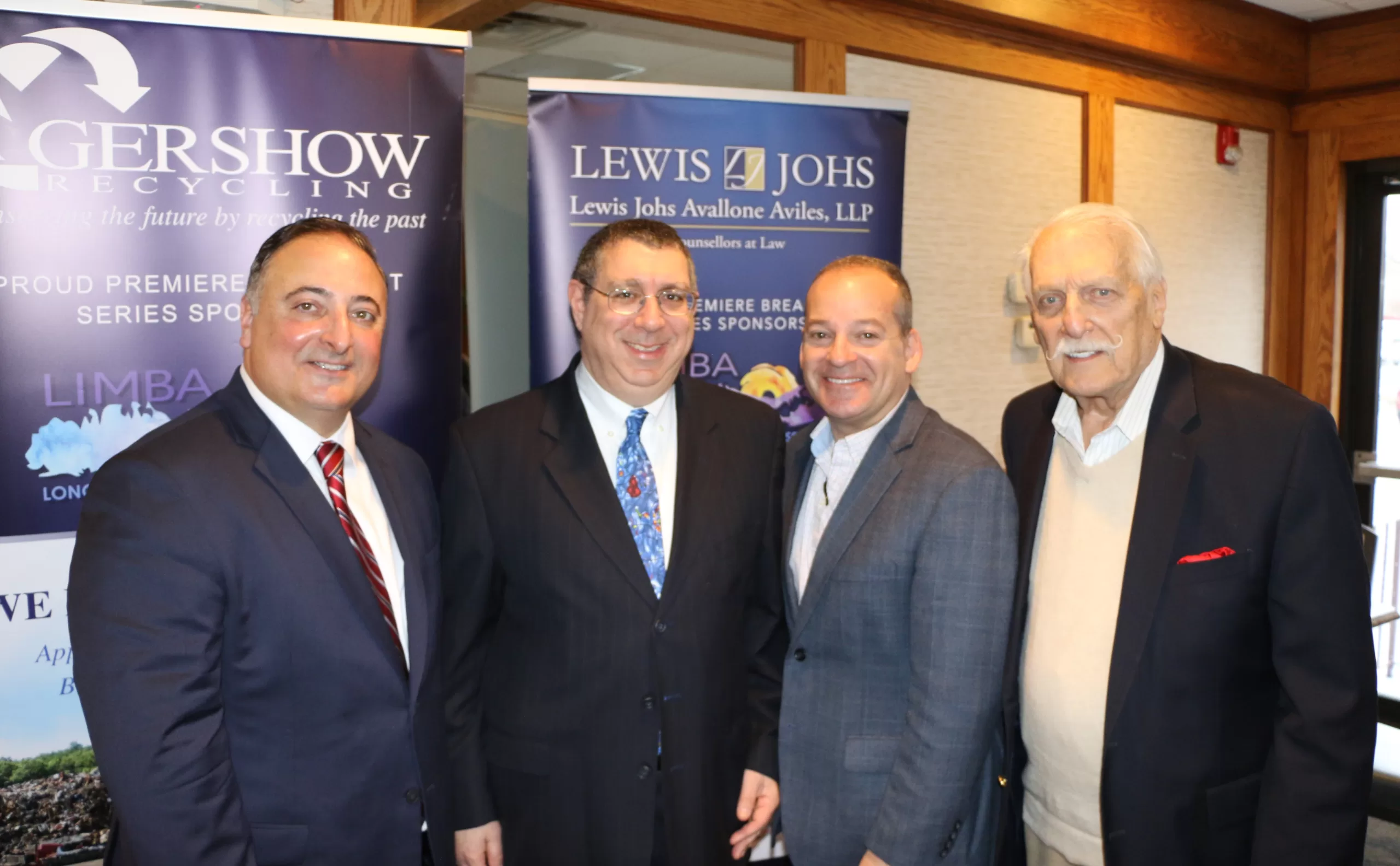
By Hank Russell
Marc Alessi, an attorney, lobbyist and serial startup tech entrepreneur, spoke about the future of wireless technology on Long Island during the LIMBA (Long Island Metro Business Action) meeting at the Candlelight Diner in Commack on January 13. He was joined by Haran C. Rashes, the associate general counsel for Extenet Systems, Inc., an owner and operator of distributed networks throughout the U.S.
As an attorney and lobbyist, Mr. Alessi has provided outside counsel services to Extenet, the nation’s largest installer of small cell distributed wireless infrastructure — the topic of the LIMBA presentation. He also represents the Tesla Science Center, where he serves as executive director. He noted that the TSC will celebrate the 50th anniversary of the first cell phone call ever made on April 3, 1973, by Marty Cooper at Motorola.
LIMBA Chairman Ernie Fazio praised Alessi for his passion for technology and his financial support of up-and-coming tech companies. “I know Marc doesn’t get behind anything that’s a bag of steam,” he said. “He looks for things that are really going to help the community.”
When Cooper suggested the company should start producing personal portable cell phones, Alessi said, he was told that it was “technologically impossible. We now know that nothing is technologically impossible. It just takes us a long time to get there.” However, the company was able to build the product and technology within six months.
Alessi also noted that Motorola, which “dominated wireless technology from the 1950s to the 1970s,” also provided pagers to doctors to use and walkie-talkies that were first used by the Chicago Police Department. Both the doctors and the police officers said “they were never giving this up,” he said.
Nikola Tesla, after whom the science center is named, predicted the prevalence of cell phones, Alessi said. Tesla told The Boston Globe in 1904 that “decades from now, a New York businessman will pull a device out of his coat pocket and call someone in the world wirelessly,” according to Alessi. He also said that Tesla was “very collaborative” when it came to sharing his technology, even with Gugliemo Marconi, who was best known for inventing the radio, but he utilized 17 of Nikola Tesla’s patents for his radio transmission. In 1947, the U.S. Supreme Court ruled that Tesla was the true inventor of radio. It is important to note that, while Marconi was only interested in one-way voice transmission, Tesla “was doing two-way voice transmission,” Alessi said.
Tesla built a laboratory in Shoreham, with funding from JP Morgan. Alessi said they are looking to build a museum and science center on the property and has received money, thanks to “a world record-breaking crowdfund” and funding from major technology companies. “When people think of Tesla, they think of electricity, alternating current … Basically, he brought alternating current to the forefront and basically powered our lives.” After focusing on electricity, “he became passionate about wireless communications. He knew it would transform our lives. He knew it would connect us.”
“It’s important for us to reflect on how important this is in our lives,” Alessi said. “I’m a little trepidatious to pontificate on where 6G and 7G [technology] goes, but that is a level of connectivity that is going to power the universe.” He said that 6G and 7G technology should be implemented “within 10 to 15 years.”
Rashes gave a brief overview of the evolution of wireless technology. He said 1G technology, which was used in the first phone call, was analog-based and delivered voice data. 2G technology, which came about in the 1990s, allowed the transmission of text. In the 2000s, 3G technology came out, allowed the transmission of photos and text; on December 31, 2022, all carriers stopped using 3G.
The next decade was 4G, which had all the qualities of 3G, but with the ability for users to browse the Internet, transmit video and even use Facetime. In the 2020s, 5G was finally introduced. “The two big things about 5G is the speed of data [transmission] and it has very low latency,” Rashes said.
According to Extenet, 5G has download speeds of 300 Megabits per second (Mbps), while the range for 4G was between 12 and 36 Mbps. While 5G will increase capacity for data and voice service, it requires more access points — also known as nodes or cells — because of its smaller footprint and emits a much lower power signal than a macro-site.
Extenet places outdoor small wireless facilities (also known as “small cells”) onto numerous properties and structures throughout the U.S. The company makes sure that its employees follow local codes and guidelines, they use the public right-of-way appropriately, and meet with city planners and local elected officials to identify the best possible site locations. Further, the antenna can take up no more than three cubic feet of space and must be aesthetically pleasing within the communities where they are installed.
Mr. Rashes said the biggest issue is the time because it takes 60 to 90 days to get approval of the small cell placements. Another issue is NIMBYism, in which the residents do not want the poles in their neighborhoods. The third issue is the “elephant in the room,” namely health and safety issues regarding cellular transmission. Mr. Alessi said 250 health studies have been done on the human body’s exposure to cellular transmission since the 1980s and the FDA conducted its own study in 2018, none of them showing adverse health effects, “but people are still freaking out.”
Among the misnomers Rashes heard about 5G transmission are that it is a new technology, it is unregulated, it relies on frequencies in the ionizing radiation band of electromagnetic frequencies, it causes changes in the weather, it increases lightning strikes and it causes COVID-19 and other illnesses. He said that the Federal Communications Commission has found small cells to be safe, provided they are properly placed.
“All 5G frequencies and 5G equipment have to be approved by the FCC and comply with FCC-mandated safety measures,” Rashes said. “They have done the safety checks and we have to comply and conduct a study on every single thing we install to make sure it complies with the commission’s standards.”
“There should be communication from the ground up and educating the public and elected officials because on issues like this, there are folks out there that are bringing out disinformation and showing up at board meetings and screaming,” Alessi added. “Without this connectivity, we fall behind on Long Island. Five years from now, 10 years from now, people are not going to want to live in a community [without wireless connectivity].”
While 5G is in “the early stages” on Long Island, Mr. Rashes pointed out other parts of the world are working on implementing next-generation cellular technology. “I don’t know where it’s going to go and where it’s going to hold,” Mr. Rashes said of 6G and 7G technology, “but we can all dream what functionality we will have then, and we hope that we’ll be around to have the capacity and bandwidth to support it.”


